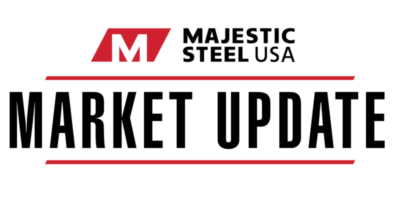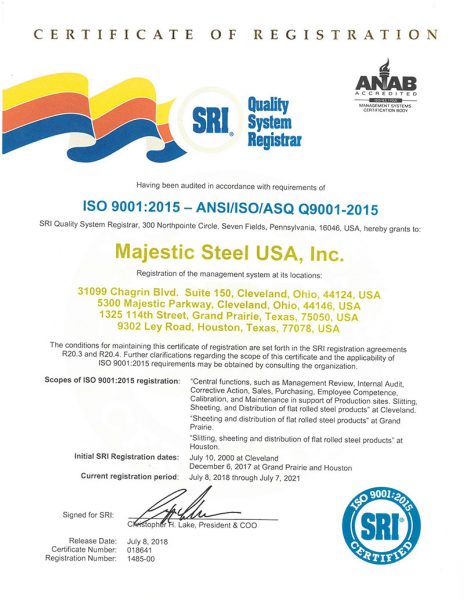Market Update | August 17, 2022
INDUSTRIAL PRODUCTION REMAINS RESILIENT
Within total industrial production, manufacturing output rebounded after sliding the previous two months, increasing 0.7%. The manufacturing increase was boosted by the sharp 6.6% increase in motor vehicle production. Total capacity utilization increased as well in July, climbing 0.4% to an 80.3% rate.
Input Costs
Zinc pricing continued to rebound this week, climbing to its highest level since early-June.
-
-
Zinc pricing climbed to $1.70/lb this week, up over 30% in the last month.
-
Spot iron ore pricing slipped this week after climbing the previous three weeks.
-
-
Despite the slide, pricing remained above $100/mt at $104.05/mt.
- Spot iron ore pricing is down 0.4% from the end of last week but is up 3.1% on a m/m basis.
-
Pacific Basin met coal pricing ended its recent slide this week, rebounded back above $250/mt.
-
-
Current pricing is at $254/mt, up 15.5% from the end of last week and 10.4% from this time last month.
-
Supply
Domestic raw steel production increased slightly last week, now up for only the second time in the last six weeks.
-
- U.S. steelmakers produced 1.742 million tons at an 79.0% utilization rate.
- YTD production is now down 3.2% from the same time last year.
Based on preliminary import licenses in August (15 days), the daily average imports were flat m/m (-6.8% y/y).
-
- Excluding slabs, daily avg imports were up 4.0% m/m.
DEMAND
Manufacturing business activity in the New York region declined sharply in August, sliding to the lowest level since early on in the pandemic.
-
-
The August Empire Manufacturing Index came in at -31.3, down sharply from 11.1 in July.
-
The two-month average declined to -10.1, its lowest level since June 2020.
- Any reading above 0.0 indicates an expansion in activity, while any reading below 0.0 denotes a contraction.
- Both new orders and shipments dropped sharply in August, sliding to -29.6 and -24.1, respectively.
- Unfilled new orders contracted at a faster rate as well, sliding to -12.7.
- When looking forward however, the view of activity six-months from now returned to expansion by climbing to 2.1.; this is up from -6.2 in July.
-
Confidence among U.S. homebuilders continued to wane in August, now weakening for the eighth consecutive month.
-
-
The August Housing Market Index came in at 49, down from 55 in July and down from 75 in August 2021.
-
This is the first time the index has been below the key 50.0 level since May 2020.
- Any reading above 50.0 indicates an increase in confidence, while any reading below 50.0 denotes a contraction.
- Of the three main components of the index, only the present situation (57) remains above 50.0.
- Both the Next Six Months and Traffic components are showing contraction, coming in at 47 and 32, respectively.
-
New residential construction continued to declined in July, with new housing starts declining for the fifth time in the first seven months of the year.
-
-
New housing starts came in at a 1.446 million unit rate, down 9.6% from June and down 8.1% from a 1.573 million unit rate in July 2021.
-
July 2022 was the lowest adjusted rate for new starts since August 2020.
- Through the first seven months of the year, actual new housing starts are still up 3.8% compared to the same timeframe last year.
- Permits, an indicator for future construction, declined as well in July.
- New permits came in at a 1.674 million unit rate, down 1.3% compared to June but up 1.1% from July 2021.
- Permits have now increased, on a year-over-year basis, for six consecutive months.
-
Total industrial production increased in July, climbing 0.6% from June.
-
-
Within total IP, manufacturing output rebounded after sliding the previous two months.
-
Manufacturing output increased 0.7% after sliding 0.4% in each of the previous two months.
- The increase in manufacturing was helped by the sharp 6.6% increase in motor vehicle production.
- Total capacity utilization increased as well in July, climbing 0.4% to a 80.3% rate.
- The increase helped keep utilization above its long run average (50 years) of 79.6%.
-
ECONOMIC
While shipments have remained virtually flat this year, the expenditures component of the Freight Index, which measures total amount spent on freight, declined in July after hitting a record high in June.
-
-
The July expenditures component slipped 3.6% from June but remained 28% higher than year-ago levels.
-
Within the year-over-year increase, roughly 8% – 10% can be directly related to increased fuel costs.
- The recent easing of fuel costs likewise, was the main driver in the month-over-month decline.
- The inferred freight rates in July, shipments divided by expenditures, eased thanks to lower fuel rates and some truck mix related noise.
- Despite the recent easing, tight supply/demand balance within the U.S. trucking market will continue to pressure rates throughout the balance of 2022.
-
U.S. retail sales came in at a $862.8 trillion rate in July, flat from June but up 10.3% from a $619.2 trillion rate in July 2021.
-
-
This was the first double-digit percentage increase on year-over-year sales since February.
-
Excluding gas, retail sales were up 0.2% compared to June, now up for the third consecutive month.
- Adjusting for inflation (using the July CPI), actual sales were up 1.4% compared to June and up 10.8% compared to July 2021.
- Compared to June, the largest increases in sales came from online retailers, building material & equipment stores, and electronic stores.
- These increases were completely offset by declines in sales from motor vehicle dealers, department stores, and gas stations.
-
This material, information and analyses (the “Content”) may include certain statements, estimates and projections prepared with respect to, among other things, historical data and anticipated performance. Content may reflect various assumptions by Majestic Steel USA, Inc. concerning anticipated results that are inherently subject to significant economic, competitive and other uncertainties and contingencies and have been included for illustrative purposes. Content is provided AS-IS.

